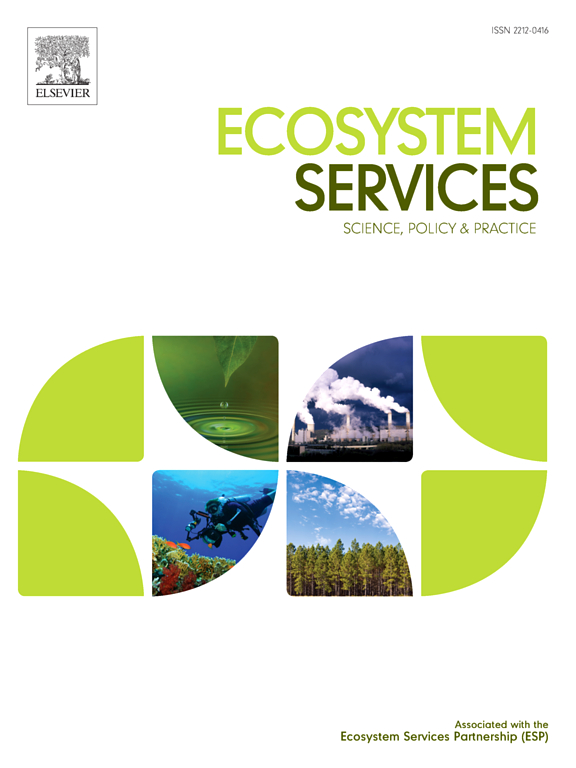多少才够?应用大数定律来测量生态系统服务之间的相互作用
IF 6.6
2区 环境科学与生态学
Q1 ECOLOGY
引用次数: 0
摘要
生态系统服务(ES)处于科学文献的前沿,在美国国家科学基金会和欧洲研究委员会以及许多其他国家研究机构的研究概况中都能找到自己的位置。然而,尽管有许多关于该主题的出版物,但数据的可用性,质量和数量以及不确定性问题仍然是该领域的限制。在最近的一项分析中,Shanafelt等人(2023)在对景观进行采样时发现了生态系统之间相互作用的总体趋势:采样10%的景观足以恢复景观尺度上测量的生态系统之间的平均相关性。在本文中,我们将深入研究这一发现。具体来说,我们应用Chebyshev不等式和大数定律来表明,随着样本量的增加,任何两个ES之间的样本相关性接近从这些服务在整个景观中的潜在统计分布中测量的“真实”值。此外,存在一个样本大小,其中样本相关性与真实值之间的差异可以容忍为零-来自Shanafelt et al.(2023)的“十分规则”。我们假设这一样本量取决于这些ES之间的潜在相关强度及其空间分布之间的相似性,并在理论生成的景观中使用回归分析来验证这一假设。最后,我们在实际的Shanafelt等人(2023)数据中测试了我们预测样本大小的能力。我们的研究结果可以应用于样本和实验设计,以及制定和实施政策。本文章由计算机程序翻译,如有差异,请以英文原文为准。
How much is enough? Applying the law of large numbers to the measurement of interactions between ecosystem services
Ecosystem services (ES) are at the forefront of the scientific literature, finding themselves in the research profiles of the National Science Foundation and European Research Council, as well as many other national research agencies. Yet despite many publications on the topic, issues of data availability, quality and quantity, and uncertainty still remain limitations to the field. In a recent analysis, Shanafelt et al. (2023) found a general trend in the interactions between ES when sampling a landscape: sampling ten percent of the landscape was sufficient to recover the mean correlation between ES measured at the landscape scale. In this paper, we delve deeper into this finding. Specifically, we apply Chebyshev’s inequality and the law of large numbers to show that as the sample size increases, the sample correlation between any two ES approaches the “true” value measured from the underlying statistical distributions of those services across the landscape. Furthermore, there exists a sample size in which the difference between the sample correlation and the true value is tolerably null – the “ten’s rule” from Shanafelt et al. (2023). We hypothesize that this sample size depends on the underlying correlation strength between those ES and the similarity between their spatial distributions, and test this hypothesis using regression analysis in theoretically-generated landscapes. Finally, we test our ability to predict this sample size in the actual Shanafelt et al. (2023) data. Our findings have applications for sample and experimental design, as well as for devising and implementing policy.
求助全文
通过发布文献求助,成功后即可免费获取论文全文。
去求助
来源期刊

Ecosystem Services
ECOLOGYENVIRONMENTAL SCIENCES&-ENVIRONMENTAL SCIENCES
CiteScore
14.90
自引率
7.90%
发文量
109
期刊介绍:
Ecosystem Services is an international, interdisciplinary journal that is associated with the Ecosystem Services Partnership (ESP). The journal is dedicated to exploring the science, policy, and practice related to ecosystem services, which are the various ways in which ecosystems contribute to human well-being, both directly and indirectly.
Ecosystem Services contributes to the broader goal of ensuring that the benefits of ecosystems are recognized, valued, and sustainably managed for the well-being of current and future generations. The journal serves as a platform for scholars, practitioners, policymakers, and other stakeholders to share their findings and insights, fostering collaboration and innovation in the field of ecosystem services.
 求助内容:
求助内容: 应助结果提醒方式:
应助结果提醒方式:


